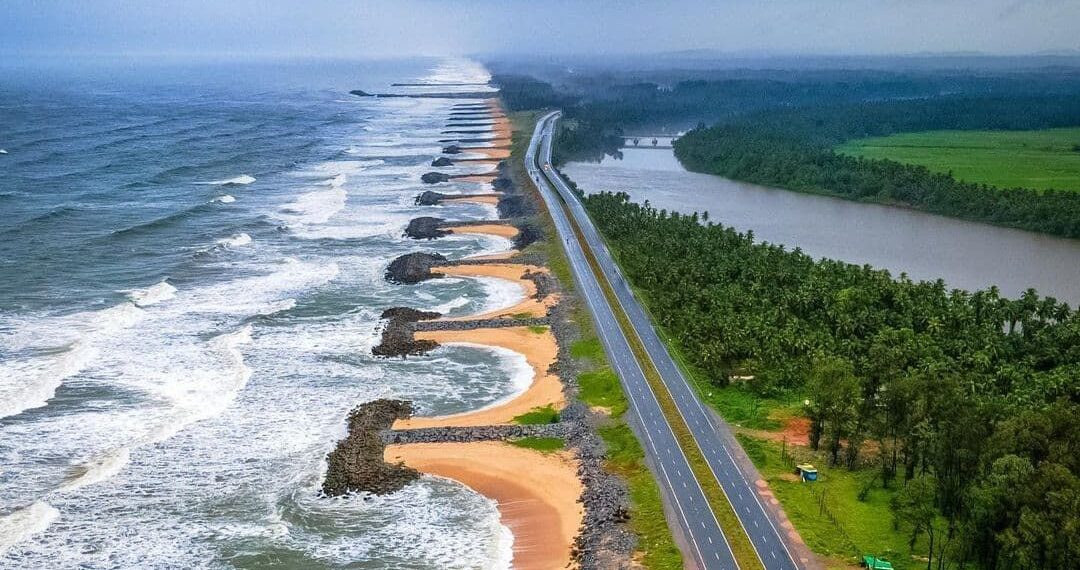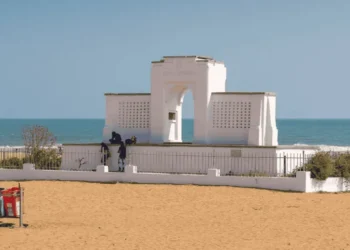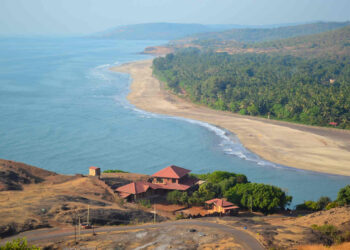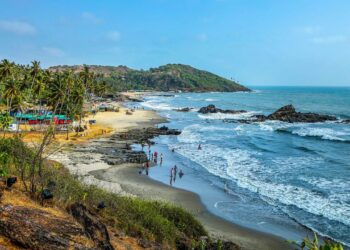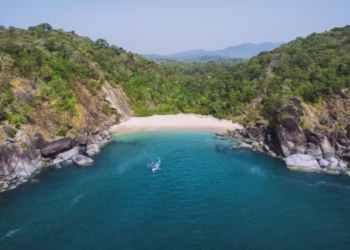Maravanthe Beach, found in Karnataka’s Udupi district, is one of those places where nature seems to have done something truly unusual. Here, the Arabian Sea lies on one side, and just across the narrow road of National Highway 66, the Souparnika River flows quietly on the other. Between the two stretches of water, a clean line of white sand runs for about a kilometer. To the east, the green slopes of the Kodachadri Hills rise in the distance, making the whole view look almost like a painting.
Often called the “Virgin Beach” because it has stayed mostly untouched, Maravanthe is peaceful and far less crowded than the busy beaches of Goa. It sits about 18 kilometers from Kundapur and roughly 55 kilometers from Udupi, making it an easy stop for travelers passing along the coastal route. Managed by Karnataka Tourism and local village councils, the beach is kept simple, there are few buildings or stalls, just sand, water, and quiet air.
A Fun Fact of Maravanthe Beach
What makes Maravanthe Beach stand out from the long stretch of Karnataka’s coastline is its strange and beautiful layout. When you drive along NH66, you can see the Arabian Sea rolling on one side and the calm Souparnika River flowing on the other, both running almost side by side but never meeting. It gives the feeling that the road is cutting right between two different worlds of water. Many people call it the “drive-through beach,” and the view often surprises first-time visitors. In 2005, Outlook Traveller named it the most beautiful beach in Karnataka, a recognition that still fits this quiet and almost forgotten place by the sea.
History of Maravanthe’s Past
The story of Maravanthe Beach goes far back in time, much like the steady flow of the Souparnika River beside it. Old remains found around this area suggest that people may have lived here more than four thousand years ago, using small canoes made from reeds to trade salt, fish, and spices with nearby villages. Around the 8th century, during the rule of the Alupa dynasty, Maravanthe began to grow as a small coastal port. Ships carrying pepper, coconuts, and local produce would stop here before heading toward trading towns in Arabia. The fishing families of Tuluva origin, who have lived here for generations, still follow many of the same traditions, going out to sea before sunrise with long nets and simple wooden boats.
During the time of the Vijayanagara Empire in the 14th century, this place became an important halt for travelers and pilgrims on their way to the Kollur Mookambika Temple, which is about 60 kilometers inland. There are local stories that say the Souparnika River was named after a sage called Suparna, who bathed here to wash away his sins. Even today, some pilgrims stop near the river to take a dip before visiting the temple.
When the Portuguese came to the western coast in the 1500s, they drew Maravanthe on their maps but never settled here. It was too quiet and far from their major ports. Later, in the 19th century, British surveyors recorded the beach as a small stop where ships could refill water and food. They also noted the dark patches in the sand caused by minerals carried from the hills.
After India’s independence, Maravanthe remained a simple fishing village. While many other beaches in Karnataka developed quickly, this one stayed calm and largely untouched. The new coastal road built in the 1990s made it easier for visitors to reach, and people began to call it the “drive-by beach.” Even then, the local community worked to protect the dunes and limit large construction near the shore.
Today, Maravanthe continues to keep its quiet charm. During the annual village festival held in January, traditional Tulu songs and dances are performed by the sea. Between November and March, some parts of the coast are protected as nesting grounds for olive ridley turtles.
Things to Do at Maravanthe Beach
Quiet Walks and Calm Views
Maravanthe Beach is more about peace than noise. Many people come here early in the morning to walk along the small stretch of road that separates the sea from the river. The path is lined with tall casuarina trees that give shade and a soft rustling sound in the wind. The air often carries a mix of sea salt and the faint smell of jasmine from the nearby hills.
Swimming and Water Sports
The water at Maravanthe stays warm and gentle, making it good for light swimming and relaxing dips. The beach is not very deep, and the waves are soft most of the year. Lifeguards are usually present during the main season from October to May.
For those who like some activity, there are options like jet skiing, kayaking, or short boat rides toward the river mouth. After the monsoon months, small waves form near the shore, and local surfers often practice here. Sometimes, people bring snorkeling gear to look at small fish near the rocks, though the corals are few and scattered. Dolphins are often seen at a distance, especially early in the morning, moving together in small groups.
Exploring the River and Surroundings
The Souparnika River beside the beach offers a different experience. Simple wooden or motor boats take visitors through its calm waters surrounded by palm trees. Some rides stop at small temples on the riverbank, like the Varahi shrine, where the story of sage Suparna is still told by local priests. The area also has small yoga spaces along the dunes, where morning sessions are held facing the hills of Kodachadri as the sun rises.
Evenings by the Sea
Evenings at Maravanthe are peaceful and slow. As the sun goes down, the sky turns orange and red, and the reflection spreads across both the river and the sea. Sometimes locals light small bonfires and even sing Konkani and Tulu songs by the shore. A few beachside huts glow under solar lights, giving the whole scene quite a calm natural charm.
